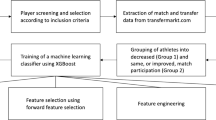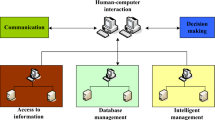Abstract
The research purposes were to explore the high-risk injury factors of basketball players’ lower limb patellar tendon enthesis based on medical big data and accurately recognize players’ lower limb injuries. Middle school students in Nanchang, the capital of Jiangxi Province, were included as the research samples. Innovatively, deep learning and artificial intelligence were applied for statistics and analysis of the collected data. The training of included samples was tracked to collect kinetic and biological data and then to analyze the high-risk injury factors of lower limbs. The analysis of basic information of the participants indicated no significant differences between the two groups. Deep learning algorithm analysis suggests that the accuracy of high-risk group and non-high-risk group is 66.82% and 66.20%, respectively. The analysis of the mechanical characteristics of patellar tendon ends of participants indicated that when the maximum flexion angles of the knee joints of the high-risk group were significantly greater than that of the non-high-risk lower limb group, there were statistically significant differences (P < 0.01). The analysis of the dynamic characteristics of the lower limbs revealed that in different action phases, the impulses of the high-risk lower limbs in the stretching and extension phase of drop landing and jump were significantly greater than that of the non-high-risk lower limbs group. In addition, in the buffer phase and the stretching and extension phase of stop jump, the impulses of lower limbs before the injury were smaller than that after the injury in the same action phases, and the differences between the impulses of stretching and extension were statistically significant (P < 0.01). The research results have processed the data through the deep learning algorithm and the parallel computing to find a joint angle that is most appropriate to make the concentration capacities of muscles reach the maximum value during the movements, thereby the damages and injuries of the body would be the lowest. The results provide a new idea for the selection of basketball court material coefficient.






Similar content being viewed by others
References
Allison K, Hall M, Hodges PW et al (2018) Gluteal tendinopathy and hip osteoarthritis: different pathologies, different hip biomechanics[J]. Gait Posture 61:459–465
Mendonça LD, Ocarino JM, Nfn B et al (2018) Association of hip and foot factors with patellar tendinopathy (jumper’s knee) in athletes[J]. J Orthop Sports Phys Ther 1:676
Habets B, Smits H W, Backx F J, et al. (2017) Hip muscle strength is decreased in middle-aged recreational male athletes with midportion Achilles tendinopathy: A cross-sectional study.[J]. Physical Therapy in Sport, 25: S1466853X1630102X.
Stojčić M, Stjepanović A, Stjepanović Đ (2019) ANFIS model for the prediction of generated electricity of photovoltaic modules[J]. Decision Making: Applications in Management and Engineering 2(1):35–48
Sremac S, Tanackov I, Kopić M et al (2018) ANFIS model for determining the economic order quantity[J]. Decision Making: Applications in Management and Engineering 1(2):81–92
Ijaz MF, Attique M, Son Y (2020) Data-driven cervical cancer prediction model with outlier detection and over-sampling methods[J]. Sensors 20(10):2809
Alfian G, Syafrudin M, Ijaz MF et al (2018) A personalized healthcare monitoring system for diabetic patients by utilizing BLE-based sensors and real-time data processing[J]. Sensors 18(7):2183
Wang Y, Widrow B, Zadeh LA et al (2016) Cognitive intelligence: Deep learning, thinking, and reasoning by brain-inspired systems[J]. International Journal of Cognitive Informatics and Natural Intelligence (IJCINI) 10(4):1–20
Ohsugi H, Tabuchi H, Enno H et al (2017) Accuracy of deep learning, a machine-learning technology, using ultra–wide-field fundus ophthalmoscopy for detecting rhegmatogenous retinal detachment[J]. Sci Rep 7(1):1–4
Ni E C, Ciocan D F, Henderson S G, et al.(2017). Efficient ranking and selection in parallel computing environments[J]. Operations Research, 65(3): 821–836.
Cao Y, Li P, Zhang Y (2018) Parallel processing algorithm for railway signal fault diagnosis data based on cloud computing[J]. Futur Gener Comput Syst 88:279–283
Ijaz MF, Alfian G, Syafrudin M et al (2018) Hybrid prediction model for type 2 diabetes and hypertension using DBSCAN-based outlier detection, synthetic minority over sampling technique (SMOTE), and random forest[J]. Appl Sci 8(8):1325
Xu Z, Wang Y, Sun N et al (2019) Parallel computing for quantitative blood flow imaging in photoacoustic microscopy[J]. Sensors 19(18):4000
Kuchibhotla KV, Gill JV, Lindsay GW et al (2017) Parallel processing by cortical inhibition enables context-dependent behavior[J]. Nat Neurosci 20(1):62–71
Pricewhelan AM, Foremanmackey D (2017) schwimmbad: A uniform interface to parallel processing pools in Python[J]. The Journal of Open Source Software 2(17):357
Zhang Y, Cao T, Li S, et al.(2016). Parallel processing systems for big data: a survey. Proceedings of the IEEE, 104(11) 2114–2136.
Chen M, Gong D (2019) Discrimination of breast tumors in ultrasonic images using an ensemble classifier based on tensorflow framework with feature selection. J Investig Med 67(Suppl 1):A3. https://doi.org/10.1136/jim-2019-000994.9
Zheng Y, Ke H (2020) The adoption of scale space hierarchical cluster analysis algorithm in the classification of rock-climbing teaching evaluation system. J Ambient Intell Human Comput. https://doi.org/10.1007/s12652-020-01778-6
Martin HD, Khoury AN, Schroder R et al (2017) The effects of hip abduction on sciatic nerve biomechanics during terminal hip flexion[J]. Journal of Hip Preservation Surgery 4(2):178–186
Mellott T J, Huleatt O M, Shade B N, et al. ( 2017) Correction: Perinatal Choline Supplementation Reduces Amyloidosis and Increases Choline Acetyltransferase Expression in the Hippocampus of the APPswePS1dE9 Alzheimer's Disease Model Mice[J]. Plos One, 12(1): e0170450.
Ohsawa S (2017) Long-term results of valgus osteotomy for terminal-stage osteoarthritis of the hip[J]. Arch Orthop Trauma Surg 137(1):1–8
Creaby MW, Honeywill C, Franettovich Smith MM et al (2017) Hip Biomechanics are altered in male runners with achilles tendinopathy[J]. Med Sci Sports Exerc 49(3):549–554
Nagasawa T, Tabuchi H, Masumoto H et al (2019) Accuracy of ultrawide-field fundus ophthalmoscopy-assisted deep learning for detecting treatment-naïve proliferative diabetic retinopathy[J]. Int Ophthalmol 39(10):2153–2159
Zhu XX, Tuia D, Mou L et al (2018) Deep learning in remote sensing: a comprehensive review and list of resources[J]. IEEE Geoscience & Remote Sensing Magazine 5(4):8–36
Akhtar N, Mian A (2018) Threat of adversarial attacks on deep learning in computer vision: a survey[J]. IEEE Access 6:14410–14430
Acknowledgements
This work was supported by Jiangxi Education Bureau (Title: Research on the Cultivation of Core Literacy in P.E. of Senior High School Students from Moral Education Perspective) and (Title: The Influencing Factors and Path Selection of the Inheritance of Red Sports Culture in the Central Soviet Area-Based on Grounded Theory).
Author information
Authors and Affiliations
Corresponding author
Ethics declarations
Conflict of interest
All authors declare that they have no conflict of interest.
Ethical approval
This article does not contain any studies with human participants or animals performed by any of the authors.
Informed consent
Informed consent was obtained from all individual participants included in the study.
Additional information
Publisher's Note
Springer Nature remains neutral with regard to jurisdictional claims in published maps and institutional affiliations.
Rights and permissions
About this article
Cite this article
Wu, H., Wang, L. Analysis of lower limb high-risk injury factors of patellar tendon enthesis of basketball players based on deep learning and big data. J Supercomput 78, 4467–4486 (2022). https://doi.org/10.1007/s11227-021-04029-3
Accepted:
Published:
Issue Date:
DOI: https://doi.org/10.1007/s11227-021-04029-3




